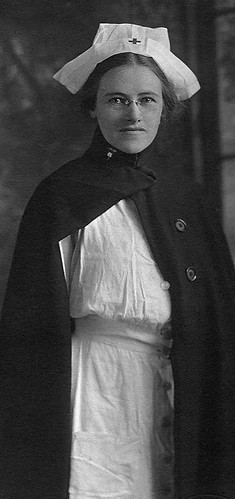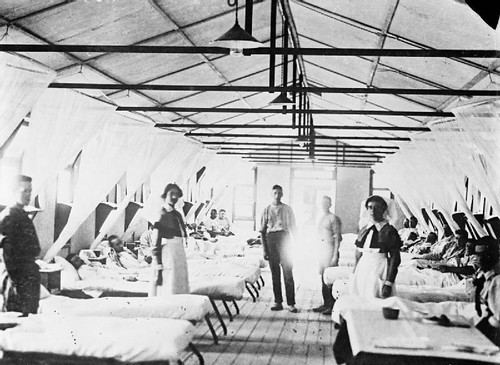They were part of a patriotic clan from Eastern Kentucky in the War to End All Wars
By Kentucky National Guard Command Historian John Trowbridge
With March being Women's History month kentuckyguard.com is publishing a series of stories celebrating Kentucky women and the roles they played in our military history. Following is one such story ....
[caption id="" align="alignleft" width="320"]

Margaret Gretchen, John Bayles, and Elizabeth Eleanor Minnich.
FRANKFORT, Ky. -- The door that barred the way to women joining the ranks of the United States military was opened slightly on 28 February 1901, with the introduction of the Nurse Corps (Female) and on 13 May 1908, with the establishment of the Navy Nurse Corps. However, it was not until the United States entered World War I that the government and the military authorities got serious about allowing women into the service.
Approximately 4,300,000 Americans served in the military during the war. Of that number an estimated 30,000 were women. American women served in the Army, Navy, Marines, and Coast Guard.
American servicewomen served around the globe; by war’s end they had seen service in the Philippines, Guam, Samoa, Haiti, Virgin Islands, England, Ireland, Scotland, France, Belgium, Italy, Serbia, Siberia, Hawaii, and Puerto Rico, in addition to various locations within the United States.
[caption id="" align="alignright" width="235"]

Elizabeth Minnich in her nurse uniform.
Many women who served overseas in combat areas suffered the same hardships and potential dangers of their male counterparts. Some women serving near the battlefront were killed in accidents, others were wounded or gassed, some died of disease. A number of American nurses are buried in military cemeteries in foreign countries far from their native soil. More than 320 American women serving in the military were casualties of the war to end all wars.
Women served valiantly with dedication and devotion to duty throughout the war. Three Army nurses were awarded the Distinguished Service Cross, twenty-three received the Distinguished Service Medal, while numerous others received a variety of citations. Four Navy nurses received the Navy Cross, while six others received citations. More than 100 Army nurses were awarded with French decorations.
The British military presented decorations to more than ninety Army nurses.
Once war ended and the role of women in the military faded, they quietly returned to their homes, families, and civilian life. Though the Army and Navy Nurse Corps continued to exist in peacetime, it would be a number of years before these women would receive the rank, pay, and benefits of their male counterparts. Many of the women “veterans” who had served in the Army Signal Corps during the war were told they would not be eligible for honorable discharge or veterans benefits. After a more than sixty-year battle, however, Congress passed Section 1414 of the GI Bill Improvement Act of 1977, finally giving the women veteran status.
During World War I, Kentucky provided approximately 250 women to the military service. These women came primarily from the nursing profession. Of the 250, fifteen were from the Appalachian region of the state.
An interesting case in point is the story of the Minnich family of Oil Springs in Johnson County, deep in the mountains of southeastern Kentucky. This mountain family provided two daughters and one son to the war effort. The three were the children of William W. and Myrain F. (Long) Minnich. Elizabeth Eleanor “Lizzie” was born on 22 November 1883, Margaret Gretchen was born on 30 July 1888, and John Bayles was born on 6 February 1890.
All three attended Berea College. Elizabeth and Margaret graduated from the College of Nursing with the class of 1909. Both women listed their home address as Olympia, Bath County. In 1911, John completed the three-year course. While attending Berea College, John dreamed of one day becoming governor of Kentucky. His working experience, however, was at Boone Tavern, and he spent his entire career in hotel management. Prior to his entry into military service, John was managing the Continental Hotel in Pineville, Bell County, Kentucky.

For nearly ten years following their graduation from Berea College, Elizabeth and Margaret worked at hospitals in Madison, Bell, Franklin, and Fayette counties. The United States entered the war on 6 April 1917. Elizabeth and Margaret joined exactly one year later, on 6 April 1918. John joined five days later, on 11 April. At time of enlistment, Elizabeth was thirty-four, Margaret was twenty-nine, and John was twenty-eight.
Both women were working for the Kentucky Public Health Nursing Association in Frankfort. Elizabeth lived at 190 North Upper Street in Lexington and is credited on official records to Fayette County. Margaret was living in the Pineville hotel managed by her brother and is credited to Bell County.
Elizabeth and Margaret joined Base Hospital No. 40, known as the “Barrow Unit” after its director, Dr. David Barrow of Lexington. In June 1917, Surgeon General William C. Gorgas authorized the organization of Base Hospital No. 40. Home for the base was Lexington’s Good Samaritan Hospital. All base hospitals were required to be sponsored by either a medical school or hospital. Organization of this unit was placed in the hands of the American Red Cross Association, with Colonel Jefferson R. Kean in charge. On 15 July 1917, Elizabeth Bogle, of Lexington, was appointed head nurse.
In December 1917, Dr. Barrow was instructed to change the original 500-bed unit to a 1,000-bed hospital, which would require an organization of thirty-three officers, 100 nurses, five civilian employees and 200 enlisted men. By late December the organization of Base Hospital No. 40 was completed, even though the nurses had not been called to active service.
Next up: Deployment and service in Europe!